How To Repair Pex Piping
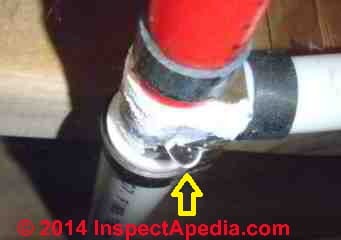 Contumely Connector Corrosion, Leaks, Dezincification in PEX Piping Systems
Contumely Connector Corrosion, Leaks, Dezincification in PEX Piping Systems
Current corrosion, links, meringue dezincification reports for PEX connectors in Ohio & Michigan
- Mail a QUESTION or Annotate about PEX polyethylene plastic supply piping brass fitting failures, corrosion, leaks, dezincification
InspectAPedia tolerates no conflicts of interest. We have no human relationship with advertisers, products, or services discussed at this website.
PEX Piping Contumely Fitting Corrosion, Leaks, & dezincification failures:
Current field reports & photographs of corrosion, leaks, & obstructive corrosion build-up inside of brass elbows, tees, & adapters used with plastic PEX h2o supply pipe.
This article reports on current observations of corrosion & leakage in PEX piping systems in recently-constructed homes in the U.Southward., particularly in Ohio & Michigan.
We as well include a field report of leaks at PEX connectors due to damaged PEX connector seal inserts in fittings used to connect the tubing to other metallic plumbing fittings such equally a shower control.
We also provide an Commodity INDEX for this topic, or you lot tin can try the page tiptop or bottom SEARCH BOX as a quick way to find information you need.
PEX Dezincification Update & Enquiry: field failure photographs of Contumely PEX Piping Plumbing equipment Corrosion & Leaks
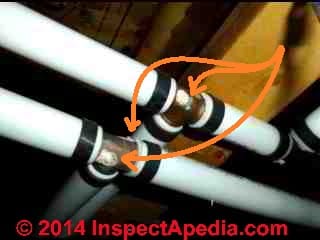
This article series discusses the properties of Pex Tubing or Piping, Cross-Linked Polyethylene (PEX).
We address pex tubing & fitting failures and leaks reported for some U.Due south. states: field photographs & reports of brass connector leaks, corrosion, blockages possibly ascribed to dezincification of contumely connectors used with PEX plumbing systems. Symptoms include visible corrosion, water leakage, & possibly obstructed water supply piping resulting in reduced h2o menstruum at fixtures.
Updates on Pex fitting de-zincification bug reported from the field. Pex dezincification research citations.
We discuss the uses of PEX tubing for water supply & in heating applications and we describe several different types of PEX tubing connector systems used including PEX crimp fittings, PEX pinch fittings, PEX expander fittings, PEX Printing-Fit connectors, and PEX Shark-Bite fittings and connectors.
[Click to enlarge any epitome]
Article Contents
- PEX Contumely CONNECTOR LEAKS
- DEFINITION of DEZINCIFICATION, BRASS, GUNMETAL
- DEZINCIFICATION CAUSES
- DE-ZINCIFICATION vs H2o SUPPLY PROPENSITY
- DEZINCIFICATION vs H2o SUPPLY pH
- DEZINCIFICATION WATER TESTS
- DEZINCIFICATION FIELD REPORTS
- Pb LEACHING WARNINGS
- DZR DEZINCIFICATION-RESISTANT FITTINGS
- RESEARCH on DEZINCIFICATION
- PEX CONNECTOR LEAKS FROM SEAL DAMAGE at Wirsbo / Uponor PEX fitrtings
Above left: perforation corrosion visible on two brass Tee-connectors installed on PEX water supply piping observed in a midwestern U.S. domicile constructed in 2009 (orangish arrows). Above right, contumely tee corrosion actualization both on the Tee-fitting body (red arrow) and around the end of the PEX tubing (greenish arrow) on water piping in a 2009 domicile. [Click to overstate any paradigm]
Definition of Brass, Gunmetal, Dezincification, & Meringue Dezincification
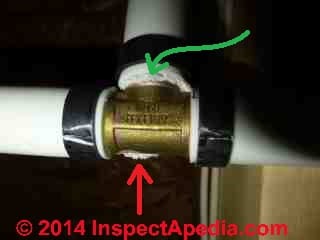 Brass is a generic term used to describe a family of alloys made principally from copper and zinc where zinc is alloyed with copper in percentages ranging from 15% to xl%.
Brass is a generic term used to describe a family of alloys made principally from copper and zinc where zinc is alloyed with copper in percentages ranging from 15% to xl%.
Some "brass" fittings sold worldwide, including plumbing fittings, may also contain lead, tin, and zinc and would more properly be chosen "gunmetals".
Gunmetal alloys are used only in the manufacture of bandage items.
The U.One thousand.'south Foundation for H2o Research explains that the part of lead in castings is to reduce the porosity of the last product: every bit lead is the last ingredient to solidify when casting a role, the lead can exist drawn into openings or pores in the production to reduce the gamble that it has a pinhole leak.
What this means to a architect, home owner, inspector or investigator of plumbing systems and water supply piping is that the observation of cast brass plumbing fittings (as opposed to machined fittings) means that the fittings may contain pb that peculiarly in the presence of low pH water (acidic water) may leach into the water supply. We discuss this concern
at Lead LEACHING WARNINGS.
Dezincification (shown below) refers to the loss of zinc from a brass plumbing fitting by dissolution, ultimately leading to leaks or broken fittings.
Zinc present in the brass alloy dissolves leaving pores or openings that tin become water leaks. Dezincification also weakens the remaining plumbing equipment, increasing the risk that the plumbing fixtures or other contumely parts such as the stem of a water command valve might break.

Meringue dezincification (shown below) is a special example of corrosion of contumely plumbing fittings that occurs in high pH water (above viii.2 or basic water), leaving corroded material equally a white deposit (probably salts) that clogs brass fittings and reduces water flow rates.
Meringue dezincification might explicate some reader reports we receive of a decrease in hot water menses rate at some plumbing fixtures, peculiarly those used most-oftentimes and at highest-temperatures.
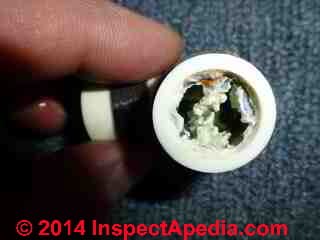
Since both clogging (meringue dezincification) and perforation leaks may occur at the aforementioned time on water supply systems, another step in identifying the type of dezincification occurring might be to test the water pH level.
Run into DE-ZINCIFICATION vs WATER CHEMISTRY
Definition & Causes of "Dezincification" & "Meringue Dezincification" of Brass Plumbing Fittings
The procedure of dezincification of contumely water piping system components includes at least the following contributors
- Water chemistry - Water pH: water of chemistries that are that loftier in pH (basic) or depression in pH (acidic) and fifty-fifty water that is neutral in pH all ultimately are expected to corrode brass plumbing fittings. However but how the corrosion is manifested (leaks, blockages, breakage failures) varies by h2o chemistry and time.
- Water chemistry - level of Chlorine: water that is high in chlorine is likely to experience faster dezincification.
Chlorine is added to both public and private h2o supplies but in our OPINION is probable to be less carefully controlled to be kept within recommended levels in private water supply systems.
- Water temperature plays a role in dezincification as well .
Though dezincification occurs in both hot and cold h2o piping, the dissolution of zinc from brass fittings by dezincification is more rapid in hot water piping and systems than in cold h2o piping. Combining hot water, loftier chlorine and low pH with contumely fittings increases the risk of dezincification and leaks in the plumbing system.
- Alloy limerick of the contumely plumbing equipment:The percentage of zinc in brass varies according to the manufacturing procedure and most likely the intended use of the product.
A brass fitting using a lower percentage of zinc is likely to suffer dezincification at a lower charge per unit than a high-zinc plumbing equipment. A "pure brass" plumbing fixtures containing only zinc may be less prone to perforation that an alloy that includes lead.
- Manufacturing process of the brass plumbing equipment: gunmetal components intended for manufacture by casting are probable to contain lead and thus may pose a hazard of atomic number 82 leaching into the water supply.
Brass that does non include lead and that is fabricated into final product form past machining is yet vulnerable to dezincification depending on h2o chemistry and temperature.
Experts such as the Foundation for Water Research in the U.Thou. point out that while both brass and gunmetal alloys are vulnerable to corrosion and dezincification, brass alloys are more vulnerable to dezincification than gunmetals.
Dezincification Propensity of the Water Supply Chemical science
Zhang (2009) ranked water supplies in different areas of the United States co-ordinate to the propensity of the water supply to encourage leaching of zinc, copper, and lead leaching over a 100-twenty-four hours test period. He ranked the following water supplies from highest to lowest.
[Tabular array construction & excerpting shown beneath are adapted from the author'south original text - Ed.]
Furnishings of H2o Chemical science on Leaching of Metals from Metal Components: Copper or Contumely Piping & Fittings | |
Propensity for Dezincification [i][4] | Selective Leaching of Zinc vs Copper [2] |
| Rhode Island | Santa Clarita |
| San Diego | San Diego |
| Santa Clarita | Chapel Colina |
| Las Vegas | Las Vegas |
| Chapel Hill | Seattle |
| Seattle | Blacksburg |
| Blacksburg | Rhode Island [3] |
Notes to the table to a higher place
Original source: Zhang, Yaofu. "Dezincification and brass lead leaching in premise plumbing systems: effects of alloy, concrete conditions and water chemistry." PhD diss., Virginia Polytechnic Institute and State University, 2009. - http://scholar.lib.vt.edu/theses/bachelor/etd-12182009-203827/unrestricted/Zhang_Y_T_2009.pdf
[i] Zinc leaches into the water supply; 100-solar day test; annotation that this same effect can cause corrosion and leaks as are illustrated and reported in this article.
[two] Focused on the last 1200 hours as indicative of a longer-term trend the tabular array order is revised as shown in this cavalcade
[3] Zhang noted that Rhode Island water has a low pH, allowing copper to deliquesce together with zinc. The author points out a consideration of import for inspectors testing the water supply: don't just test for high chlorine. A depression pH water supply may cause brass fittings to neglect by general corrosion rather than dezincification.
[4] Interestingly the author found that either a focus on the last test period (when corrosion was most advanced and presumably the charge per unit of corrosion was accelerating) or on the total weight loss of the metal components (how much fabric has been lost) gave the same ranking later loose calibration material was removed to leave only the contumely intact.
Water Chemistry: Furnishings pH on Contumely Fittings
Effects of Low pH Water on Brass Fittings: Corrosion
Zhang (2009) observed that water that is low in pH (such as in Rhode Island in the U.Southward.) is probable to crusade brass fittings to fail past general corrosion rather than meringue dezincification. That's because low pH allows both copper and zinc to dissolve together. Water with a depression pH means that the water is "acidic" to use a term familiar to many people.
The significance of Zhang's observation is that nosotros might find PEX brass fittings or other brass pipe or fittings declining and leaking "prematurely" on water supplies that are of low pH regardless of the chlorine level, or exacerbated if the water supply is low in pH and chlorine is being added at high levels.
Effects of High pH H2o on Brass Fittings: precipitation & clogging - Meringue Dezincification
The Foundation for H2o Research (FWR) points out that high pH water (water that is basic or has a pH above viii.ii) causes corroded ingredients of a contumely plumbing fixtures to precipitate out of the water supply and to settle in the plumbing equipment itself. This effect leads to clogging: reduced water menses through the system, and is referred to throughout contemporary brass fitting failure literature as "meringue dezincification".
Effects of Neutral pH Water on Water Pipe Systems
Neutral pH water is water with a pH in the range of 7.6 to 8.two. When the water supply is maintained within this neutral pH range contumely fittings and other brass components in h2o supply systems (such as control or stop valve stems & gate valve components) will still experience corrosion, but at a slower rate. The FWR report we cite
at RESEARCH on DEZINCIFICATION
states that in this neutral pH range there volition exist no build up of a corroded material deposit (no meringue dezincification) and that "... it takes in the region of 15 years for the walls of the fittings to become penetrated.
The snapping of tap and valve spindles ... is another manifestation of the trouble." - Foundation for H2o Inquiry (2003).
Run into WELL DISINFECTANT pH Adjustment
The FWR concludes (for U.Thousand. Readers - as recommendations in other countries may vary) that plumbers should use only dezincification-immune (gunmetal) or dezincification-resistant (marked DR in the U.Thou.) brasses on water supply systems that initiate or propagate dezincification corrosion.
Watch out: since gunmetal fittings may contain lead there could still be a lead leach-out and water contamination concern. In the Eastward.U., a 2013 EC directive restricts the allowable level of lead in drinking water to fifteen mcg/L (micrograms per litre).
In the U.K. and the residue of the E.C., encounter
- European Council Directive 98/93/EC, 3 November 1998, Quality of Water Intended for Human Consumption
- EN 15664-one:2008, Influence of metallic materials on water intended for human consumption. Dynamic rig test for cess of metal release. Design and operation.
- EN 15664-2: 2010, Influence of metallic materials on water intended for homo consumption, function 2.
Uncomplicated Inexpensive Methods of Testing the Water Supply for Chlorine & pH
For investigators of dezincification who are including h2o testing in their inspection procedure, nosotros propose that In addition to testing for the chlorine level, investigators should test the h2o pH.

Testing the pH of a water supply is as easy as testing its chlorine level equally simple litmus paper strips will suffice to make a general test of the pH of a h2o supply.
While our correspondent, an inspector discussing dezincification, described using pH testing in the field, he warned that most field inspectos are non attempting the same level of testing as might be performed past a more than-skillful water testing laboratory.
Nonetheless simple pH testing by litmus newspaper or by instrument is widely used by water test services as well as those building inspectors who perform basic investigation services. And if conducted properly (for example using fresh, uncontaminated litmus paper tests), measuring water pH using litmus newspaper strips is an accurate approach.
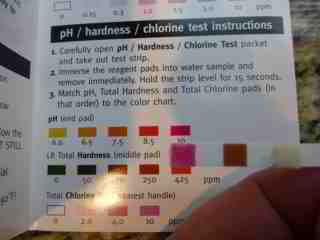
Both litmus paper and pH meters can be used to perform this examination and have been in wide use for a over 100 years since Sorensen (1909) commencement proposed this exam. Contemporary pH meters and litmus paper are in fact similarly accurate. Kahn points out that
The significance of changes in pH level, for instance, differ slightly depending on whether pH is measured by litmus newspaper or the more accurate pH meter. - Kahn (1985)
while Thomas (discussing measurement of soil acidity) points out that
As recently equally 2 decades ago, the use of the small, handheld portable pH meters then available to determine pH in the field was a very imprecise and hazardous undertaking because both electrodes and meters were field of study to sudden failures but this has changed rather abruptly in the concluding few years. Microcircuitry and plastic accept contributed to rugged pH meters and electrodes that witstand ... - Thoms (1996)
Scout out: What about pH variations over time? A unmarried pH test of a water supply can be taken merely as a reasonable judge of the h2o's chemistry at the time the examination was taken. While the pH of most water supply systems is probably rather consequent over fourth dimension, environmental, weather, or other variables might cause pH values to vary in private water supply systems and perhaps even in municipal water supplies.
In addition to the RESEARCH on DEZINCIFICATION in this article, also see the water pH testing inquiry institute at this article's REFERENCES department.
If you determine to brand some tests including pH I hope you'll report the results to us.
See WELL DISINFECTANT pH ADJUSTMENT for a give-and-take of the human relationship between chlorine and water pH.
Reader Reports PEX piping brass fitting dezincification in Ohio & Michigan, U.S.
Comment: astringent corrosion & leak at brass TEE on PEX condensate bleed pipage
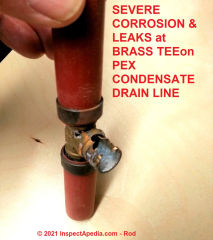 2021/04/03 Rod said:
2021/04/03 Rod said:
My 10 year old (+or -) gas furnace has a condensate pump. The installer used a 3/4" pex west/ contumely plumbing fixtures between the furnace and pump, which I recently discovered was completely eaten through. The immediate fix is replacing the plumbing equipment with a plastic ane, just who knows what this has done to my cast atomic number 26 bleed piping!
I recollect condensate neutralizers should be required past code (if they're not) and installed as a thing of course. They're a lot cheaper than fixing leaking pipes.
This word was posted originally at
CONDENSATE PUMPS
Moderator reply:
Thank you for the helpful field failure report of severe corrosion at a brass PEX connecting tee handling gas furnace condensate;
I'll be certain to keep your photo and report with that topic whose link I'll requite here;
Tin can y'all see if there is a make or identification marking of any kind on that correded brass Tee?
I ask because you'll see there was a well-known brass connector corrosion, leak failure trouble a while back - run into details
at
See PEX BRASS CONNECTOR LEAKS - field reports of de-zincification corrosion and leaks at brass PEX pipe connectors, elbows & tees.
at
inspectapedia.com/plumbing/PEX_Brass_Fitting_Leaks_De_Zincification.php
I'll re-create this conversation over to that page to invite comment from others who have seen this problem.
And I agree that corrosivity of condensate from a condensing gas furnace is a business - every bit has beeen noted in enquiry going dorsum at to the lowest degree half a century. Some examples are below.
- Boulton, L. H. CORROSION OF Edifice Avails–PROBLEMS AND PREVENTION [PDF Les Boulton & Associates Ltd. Auckland, New Zealand, at Australian website corrosion.com.au, retrieved 2021/04/04
- Brodrick, James R., and Alex Moore. Acquisition CORROSION [in gas furnaces and vent systems], [PDF] ASHRAE Periodical 42, no. 4 (2000): 29.
Introduction:
During the 20th century, concerns nigh corrosion in the components of furnaces and vent systems express the upper efficiency level for safe practise. The initial entry into the condensing regime resulted in many setbacks and financially ruined businesses.More than 50 years afterward the onset of corrosion problems, a remedy was found. Materials inquiry played a key role in reducing the corrosion problem. Market forces, such as fuel toll variations, beginning reduced and then accelerated the R&D that was needed to overcome the corrosion problem. A cursory, selected history is provided on the fundamental players, dates, and events of this R&D quest. Just, have the R&D costs and ensuing benefits paid off for the U.South. consumer?
- DeWerth, D. West., and A. Chiliad. Waters. "Corrosive effects of condensate." (1981).
- Hindin, Barry, and Arun M. Agrawal. "Materials Performance for Residential High Efficiency Condensing Furnaces." In The Employ of Constructed Environments for Corrosion Testing. ASTM International, 1988.
Abstract
In high efficiency furnaces, the condensate that is produced from the flue gas contains trace amounts of such contaminants as SOx=, Cl− (chloride ions), NO3− (nitrate ion), NO2− (nitrate ion), F− (fluoride ions), and organic acids. The condensate later on concentration by reevaporation becomes very corrosive to the heat exchanger materials. An electrochemical investigation has been conducted using 316L every bit a reference blend and synthetic condensates to identify the environmental factors most significant in corrosion.
The condensates were formulated using a statistical experimental design approach. Through a regression analysis of the results, chloride and temperature were identified as the most damaging factors. Investigation of several other alloys in an aggressive condensate showed that their corrosion performance was dependent upon their Cr and Mo contents. Later on, a large number of alloys were evaluated in a gas-fired furnace by exposing them to chloride-spiked condensates under alternate wetting and drying weather condition for xc days.
The alloys included austenitic, ferritic, and duplex stainless steels, and also a few aluminum, copper, and nickel-based alloys. Most of the alloys performed well in the condensate having 26 ppm Cl−; a few of the alloys did well in 200 ppm Cl−, but at 1000 ppm Cl− only those alloys which had high Cr and Mo contents survived.
- Huijbregts, Westward. M. M., and R. G. I. Leferink. "Latest advances in the understanding of acrid dewpoint corrosion: corrosion and stress corrosion smashing in combustion gas condensates." Anti-Corrosion Methods and Materials (2004).
Abstruse:Corrosion failures due to condensing flue gases containing H2O, SO3, NOx and HCl still occur more often than might be expected. The corrosion failures tin can be of several types: full general corrosion, pitting set on and stress corrosion cracking (SCC). The chemistry of condensing gases is discussed, and some examples of corrosion in large‐scale installations are presented, including boom stoves for steel production, heat recovery steam generators, and waste matter incineration boilers.
The utilize of thermal insulation inside boiler casings tin outcome in nitrate SCC when the flue gas contains high concentrations of NOx. Nitric acid from flue gas tin react with carbon steel and insulation material forming ammonium nitrate and calcium nitrate. Both materials have hygroscopic properties and are very corrosive, even higher up the water dewpoint of the gases.
- Miller, Westward. K., R. Shipley, R. Parrington, and D. Dennies. "Stress-corrosion bang-up." (1993).
8/19/2014 Bearding said:
Nosotros are experiencing quite a lot of PEX brass plumbing equipment dezincification in Ohio and Michigan, with increasing issues with PEX brass plumbing fixtures corrosion anywhere from 1997 through 2013 structure.
Our water is supplied from Lake Erie and you may be well aware of the water issues nosotros take experienced since about 2008 with green algae blooms and the efforts to treat the drinking water.


At in a higher place left we observe multiple perforation & corrosion deterioration of this brass PEX pipage tee and yellow / green stains that suggest that the corrosion has advanced to the signal of agile water leakage (yellow arrow). At in a higher place right we can observe water dripping from this notwithstanding more severely-corroded brass PEX pipe tee (yellow arrow).
From minor about nonexistent corrosion on the brass fitting exterior to agile leakage from plumbing fixtures failure due to leaching out of the zinc. Is there any information compilation y'all are preparing for the public to educate themselves on related to zinc fitting issues from the late 1990's to 2013?
There is no i manufacturer whose fittings we see issues with. We do non run across Kitec™ issues as there has been very limited usage in the region. We have seen Zurn - Qest™ and Nibco™ as the main brands of leaky contumely fittings in this awarding.
Thanks. Note I take photos etc. if interested in continuing this word. [Photographs of de-zincification in PEX pipe connectors & fittings are reprinted herein with permission of contributors who requested anonymity, 12 Sept 2014 - Ed.]
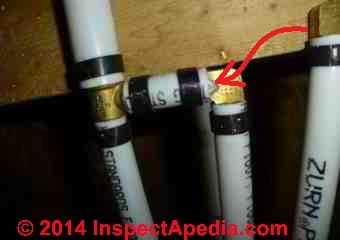
At higher up left nosotros run into white corrosion creeping along the side of a contumely elbow that was used to connect segments of Zurn® PEX white piping in a habitation synthetic in 2004.
Below is an example of brass coupling corrosion connecting copper pipage to PEX pipe in a midwestern country home constructed in 2003.
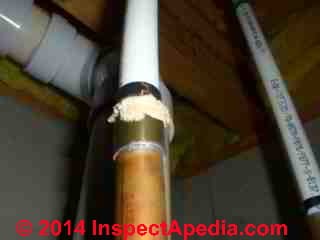
[Click to enlarge any image]
Reply:
It's worrisome that dezincification of PEX fittings continues as an ongoing issue. Please utilize my email institute at our CONTACT link to ship me whatever photos, reports, documents you can for publishing here both to inform other readers and to solicit additional field reports, research & advice regarding contemporary or ongoing PEX pipe connector & fitting corrosion, leaks or failures.
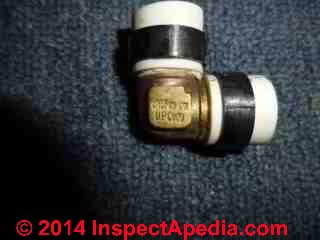
In a higher place & beneath are identification photographs of a NIBCO brass PEX elbow removed from a domestic water heater piping installation.
The readers made clear that the dezincification / brass PEX plumbing fixtures corrosion and leak problems they are observing in Midwestern U.S. states practise not appear to be confined to a single manufacturer or make.
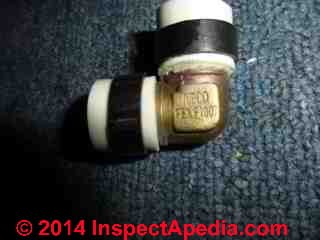
At below left the contributors illustrate perforation corrosion of a brass PEX Tee plumbing fixtures.
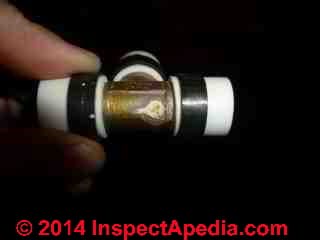
Below yous tin can discover the considerable deposit of minerals / corrosion material congenital-up inside the body of this contumely PEX Tee fitting.

This detail form of dezincification is identified as meringue dezincification and produces clogging and reduced water menses rates.
Even before building occupants find the effects of corroded leaky PEX contumely pipage fittings they may written report a symptom of reduced water menses rate and they may notice that effect starting time at the hot water side of plumbing fixtures.
Also meet Clogged SUPPLY PIPES, DIAGNOSIS
PEX Fitting & Tubing Failures, Class Action Litigation Information
The PEX brass fitting manufacturing companies mentioned in the readers' observations include
- Qitec, Inc., perhaps misnamed by the author: see Kitec® (IPEC) discussed first at PEX PIPING Information. IPEX recalled Kitec®, or Kyetec brand of brass plumbing fittings in 2005.
Also see Kitek® PLASTIC PIPELEAKS & LAWSUIT - separate commodity that discusses this class action settlement from which we extract:
The Settlement creates a 1 hundred and xx v million U.Southward. dollar (United states of america$125,000,000) Settlement Fund (less attorneys' fees and costs set forth beneath) to be used for the benefit of the Class to pay for the repair of buildings, residences, homes or other structures plumbed with the Kitec Organization. Any money paid from the Settlement Fund to members of the Settlement Classes will exist paid in the class member'southward local currency. The Program Of Allocation describes the amounts and weather of the benefits to the Class. NOTE: To be eligible to receive whatever money from the Settlement Fund, y'all must complete and submit the Claim Form accompanying the Notice bachelor on the Example Documents folio. The claim filing deadline is January nine, 2020.
After the Claims Borderline, whatsoever funds remaining in the Settlement Fund subsequently all payments to those Class Members filing proper Claim Forms, volition be returned to the IPEX Funding Entities. Claims made after the Claims Deadline will exist rejected.
- retrieved nine/eleven/14, original source http://www.kitecsettlement.com/faq.cfm - NIBCO INC. 1516 Middlebury Street P.O. Box 1167 Elkhart, IN 46515-1167, Website: http://world wide web.nibco.com/
Quoting from the visitor's product description:
The NIBCO® PEX system offers a variety of fittings to accommodate diverse types of installations. Choose from metal fittings, poly fittings, or poly Push 'Northward Go® fittings featuring the push connectedness method. NIBCO® PEX fittings, tubing, valves, and manifolds are designed to exist used as a complete system.Phone / Fax – U.Southward.:
Customer Service Phone (Toll-Gratis): 800.234.0227
Customer Service Fax (Cost-Free): 800.234.0557
Tech Services (Price-Free): 888.446.4226
Tech Services Fax (Toll-Free): 888.336.4226Phone / Fax – International:
International Telephone: +1/574.295.3221
International Fax: +i/574.295.3455
E-mail:Customer Service: CustomerService@nibco.com
Technical Services: CS-TechnicalServices@nibco.com
Public Relations: pr@nibco.com
International Customer Service: International@nibco.com
More Reader Reports of Pex brass plumbing equipment dezincification:
(Aug 19, 2014 & atain 12 March 2015) an bearding home inspector said:
We are experiencing quite a lot of PEX brass fitting dezincification in the NW OH, SE MI region. From modest about nonexistent corrosion on the brass plumbing equipment exterior to agile leakage from fitting failure due to leaching out of the zinc.
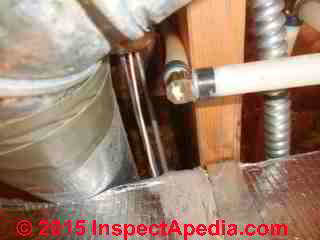
Is there whatever information compilation you are preparing for the public to brainwash themselves on related to zinc fitting issues from the belatedly 1990's to 2013? There is no one manufacturer whose fittings nosotros encounter issues with. Nibco and Qitec are the top ii that seem to be used in our marketplace.
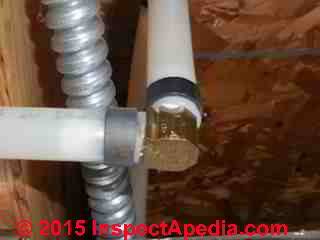
Thanks. Annotation I accept photos etc. if interested in standing this give-and-take.
12 March 2015 Anonymous wrote:
Dan, I have a few additional photos of PEX fittings showing an interesting perspective. When you receive them, note the build upwardly of the "meringue" corrosion inside the tubing that extends from the plumbing fixtures.
The home was constructed in 1995 widening our area of concern to before than 1997 every bit nosotros had previously identified through research and inspection findings. The PH levels in the regional public water supply take been found to be in elevated levels. We might arraign some of this on the contempo algal bloom problems we accept been dealing with in the Lake Erie western basin.
Reply:
Betimes: A search of InspectApedia for "Dezincification" volition find this and other related articles on the topic.
It's worrisome to hear that fifty-fifty in 2015 dezincification of brass fittings used with PEX piping is a continuing issue. Only the research in this field relating dezincification to water chemistry is both diagnostic and prescriptive.
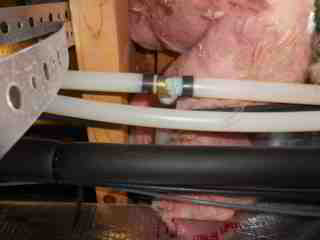
Meanwhile in the article in a higher place I've added your 2015 merengue dezincification photos to your earlier written report and some updated inquiry citations on PEX and dezincification issues
We thus invite further comment from others.
Warnings About Lead & Copper Leaching into the Water Supply from Contumely Piping, Fittings, Faucets - Water Chemistry Role
Watch out: some of the water conditions, peculiarly high levels of chlorine, that appear to play an important function in meringue dezincification of brass fittings on PEX piping systems may issue in dangerous levels of lead too as loftier levels of copper in the building water supply. Enquiry by Kimborough (2007), Kumar (2007) and Zhang (2009) as well as other researchers warns that h2o chemistry combined with the backdrop of brass, copper, and lead and zinc-containing alloys tin can lead to trouble.
The following is excerpted from Zhang (2009):
Lead and zinc leaching from a range of brasses were negatively correlated. The mechanism behind this observation is not clear even so and needs future studies. But as a result DZR and ruddy brasses release more lead to water, and a greater percentage of lead in the alloy to water.
Lead leaching is too found to be greatly influenced by h2o compositions. Higher chloride and lower alkalinity increase lead leaching. Orthophosphate at 1.4 mg/L decreases lead leaching, simply the inhibitive furnishings are very sensitive to phosphate dosages.
Initially, dosing xl mg/L of silicate besides inhibited atomic number 82 leaching, but the inhibitive upshot of silicate diminished after 100 days of experiment. Adding 200 ppb of zinc slightly increased the lead concentrations in the water. Zinc does not seem to play a meaning function in mitigating either dezincification or lead leaching from brass alloys.
When different water and the same alloy are considered, lead leaching was institute to increase with higher zinc leaching. This result may aid explain why some lead leaching cases were related with dezincification in practice.
Overall, there is a complex interplay between water chemistry and metallurgical composition that determines lead leaching to water. - Zhang, Yaofu. "Dezincification and brass lead leaching in premise plumbing systems: furnishings of alloy, concrete conditions and h2o chemistry." PhD diss., Virginia Polytechnic Plant and State Academy, 2009.
See LEAD IN DRINKING H2o, HOW to REDUCE
DZR Brass: Dezincification-Resistant Plumbing Fittings
DZR or dezincification resistant fittings should be used to avert future leaks and supply pipage clogs due to dezincification, and are likely to exist specified as the repair where h2o chemistry has already lead to contumely fitting leaks or clogs.
Some companies already DZR-Brass fittings or alternatives including
- Nibco - http://www.nibco.com/fittings/metal-fittings/force per unit area-fittings/pb-free-bandage-dzr-brass-fittings/
- Sioux Chief - http://www.siouxchief.com/no-lead/no-lead-product-markings
- Uponor'due south WIPEX fittings - DZR brass: http://www.uponor-usa.com/~/media/Uponor/Sidebar%20Brochures/LFBrsFitt_ProdG_1-10.ashx
- Incledon (note the location) - http://www.incledon.co.za/catalogues/14%20Valves%20General%20Purpose/3%20Cobra%20DZR_BRASS.pdf
Watch out: Danish researchers Andersen et als. establish water damage due to corrosion even where DZR brass was used. The bug occur where the water supply has high electrical conductivity - or every bit their paper cites, high alkalinity. Quoting:
In Danish drinking water installations, contumely has been the most commonly used textile for fittings such every bit stop valves and control valves; dezincification resistant (DZR) contumely of the type CuZn36Pb2As being the dominating alloy.
DZR brass has traditionally been considered sufficiently corrosion-resistant to exist used in all Danish water types, and previous experience has been practiced. However, today, an increasing number of severe h2o harm caused past corrosion of DZR brass in areas with difficult, high conductivity ground water has increased the focus on corrosion of copper alloys and, equally a consequence, recommendations have changed .
In the Copenhagen expanse and other areas with similar water quality, it is now recommended to utilise fittings of gun metal or stainless steel (AISI 316 or better).
...
Examinations confirm that the traditional copper alloys have unacceptably short life expectancy in the hard, loftier conductivity water types constitute in Denmark. A major reason is believed to be that the preferred pipe material has inverse from hot-dip galvanised steel to stainless steel and plastic. - Anderson et. als (2015).
Research citations on PEX and dezincification problems
- Asbjørn Andersen, Frank Fontenay, Lisbeth Rischel Hilbert, "Corrosion of brass in drinking water with loftier alkalinity", FORCE Technology, Denmark, Paper no. 4809 EUROCORR 2011 Conference Stockholm September 4th-8th 2011, retrieved 12 March 2015, original source: world wide web.forcetechnology.com
- A. Andersen, F. Fontenay, S. Klingaard, 1000. Nielsen, SBI anvisning 227, Korrosion i VVS Installationer, Statens Byggeforskningsinstitut, 2009.
- ASTM B 828-02 "Standard Practice for Making Joints past Soldering of Copper to Copper Blend Tube and Fitting."
- M. Ebner, Kupfer-Zink-Legierungen, Korrosionsphänomene und Möglichheiten ihrer Verhinderung, Sanitär und Heizungstechnik iv/2011.
- F. Fontenay, A. Andersen, S. Klingaard, failure of new brass components in high electrical conductivity drinking water due to intergranular corrosion and stress corrosion bully, NKM15 2010.
- Foundation for H2o Research, "Causes of Copper Corrosion in Plumbing Systems", (2003) Foundation for Water Enquiry, Allen House, The Listons, Liston Road, Marlow, Bucks SL7 1FD, U.K., Tel: 44 (0) 1628 891589, Email: office@fwr.org.uk Website: www.fwr.org, retrieved 12 March 2015, - original source: http://world wide web.fwr.org/copper.pdf
- "REVISION RECORD FOR THE State OF CALIFORNIA EMERGENCY SUPPLEMENT August xviii, 2010 2007 Championship 24, Part 5, California Plumbing Code." EMERGENCY (2010).
- Hilbert, L. R., H. J. Albrechtsen, and A. Andersen. "Upshot of textile and h2o quality on disinfection and risks of corrosion." In The Almanac Congress of the European Federation of Corrosion Eurocorr. 2010.
- Kimbrough, D. E. "Contumely corrosion as a source of pb and copper in traditional and all-plastic distribution systems." Periodical of American Water Works Association 99, no. eight (August 2007): 70-76.
- Kitek® PLASTIC PIPE LEAKS, Grade Action SETTLEMENT
- Kumar, S., T. S. N. Sankara Narayanan, A. Manimaran, and 1000. S. Kumar. "Effect of Lead concent on the dezincification behaviour of leaded contumely in neutral and acidified 3.v% NaCl solution." Materials Chemistry and Physics 106 (2007): 134-141
- Lawrence, Benjamin L. "Sulfur treatment for copper zinc alloys." U.South. Patent Application 13/302,374, filed November 22, 2011.
- 26 October 2018 NIBCO PEX Class Action Lawsuit [PDF] opened, petaining to owners or occupants of NIBCO PEX plumbed buildings betweeen 1 Jan 2005 and the date of the class action accommodate; (A closure engagement is not yet evident - Ed.)
NIBCO PEX Tubing: PEX tubing manufactured or sold by NIBCO in the United states of america using (or labeled by NIBCO as using) its 1006 formulation and used in residential or commercial structures, including NIBCO NEXT-Pure Tubing, NIBCO DURA-PEX
Tubing, and NIBCO. The Tubing was manufactured until 2012.NIBCO PEX Fittings: ASTM F1807 yellowish brass fittings manufactured or sold by NIBCO in the United States for employ in PEX applications and used in residential or commercial structures. NIBCO stopped manufacturing this production in 2015, though the significant majority had been manufactured and sold by the end of 2012.
NIBCO PEX Tubing Clamps: Stainless steel clamps manufactured or sold by NIBCO in the Us for utilise in PEX applications and used in residential or commercial structures. NIBCO stopped manufacturing this product in 2015, though the significant bulk had been manufactured and sold by the end of 2012.
More than information: NIBCO PEX SETTLEMENT CLAIMS WEBSITE at https://www.pexsystemsettlement.com/ providing claims forms, contact data and other information for consumers.
KIMBERLY COLE, et al, on behalf of themselves and all others similarly situated, [PDF] Plaintiffs, vs. NIBCO, Inc., Defendant Usa District Courtroom FOR THE Commune OF NEW Bailiwick of jersey Civil Activity No. 13-cv-7871 (FLW)(TJB)]
Excerpt: If the Qualifying Leak occurred between January 1, 2005 and May 16th, 2019 (the Constructive Date), the deadline for submitting a Claim Form is October 13, 2019 (150 days after the Effective Date). If the Qualifying Leak occurs during the Merits Menses and after May 16th, 2019 (the Constructive Engagement), the deadline for submitting a Claim Grade is 150 days later on the Qualifying Leak occurs.
If iii (iii) or more Qualifying Leaks are experienced, the deadline for submitting a re-plumb merits is October thirteen, 2019, (150 days after the Effective Appointment) if the leaks were experienced before May 16th, 2019 (the Constructive Date) or 150 days after the third Qualifying Leak occurs if such third leak occurs later on May 16th, 2019 (the Constructive Date). The Claim Form is available on this website.
Run across as well the NIBCO PEX CLASS Activity SETTLEMENT NOTICE [PDF] at https://www.pexsystemsettlement.com/ Tel: ane-855-649-5968 Email: info@PexSystemSettlement.com.
See as well PEX Contumely CONNECTOR LEAKS - web article
- Nielsen, K. "Metallic materials in Danish supply water systems." H2o Science & Technology: Water Supply 1, no. 3 (2001): 83-90.
- Paige, J. I., and B. S. Covino. "Leachability of pb from selected copper-base alloys." Corrosion 48, no. 12 (December 1992): 1040-1046.
- Phillips, R. John. "In pursuit of the perfect pipe." Journal of Failure Analysis and Prevention four, no. 1 (2004): 8-eleven.
- Russell, Larry Fifty. "Dezincification of brass fittings–effects of metallic solvency command measures." In Metals and Related Substances in Drinking H2o: Proceedings of the 4th International Conference, Meteau, p. 216. IWA Publishing, 2012.
- Samuels, Due east. R., and J. C. Meranger. "Preliminary studies on the leaching of some trace metals from kitchen faucets." H2o Research eighteen, no. one (Janurary 1984): 75-lxxx
- Schock, K. R., and C. H. Neff. "Trace Metallic Contagion From Brass Fittings." Journal AWWA fourscore, no. 11 (November 1988): 47-56
- VERDEJO Five. VANGUARD PIPING SYSTEMS, INC., Instance No. BC448383, [PDF - Settlement Understanding] Action filed 28 October 2010 in the Superior Courtroom of the Country of California, County of Los Angeles before the Honorable William F. Highberger.
The parties take settled the Litigation and the settlement was approved and judgment entered. This class action arose out of the installation of allegedly defective loftier-zinc-content "yellowish brass" plumbing fittings in residences.
KEY DATES in the Verdejo v Vanguard settlement agreement :
Deadline for filing claims arising from damages occurring on or after 10 July 2014: Inside 180 days from appointment of accrual
Deadline for filing claims regarding useful life: 10 July 2015
Deadline for filing claims arising from damages occurring earlier 10 July 2014: half-dozen January 2015
Discover OF PENDENCY AND PROPOSED SETTLEMENT OF Course ACTION Relating to Vanguard and Viega-brand brass plumbing components [PDF]
Verdejo v. Vanguard Piping Systems, Inc. [PDF, Final Judgment], 17 September 2014
This website, hosted past a grade activity litigation law firm https://eclaim.kccllc.internet/caclaimforms/vpv/domicile.aspx details how the settlement may impact your legal rights and your options if you are a Class Fellow member.
Excerpt:
Plaintiffs criminate they have suffered injuries and damages arising out of alleged defects in certain brass potable water plumbing system fittings or other components and sub-components used in potable water plumbing systems made from UNS C36000, UNS C37700, UNS C36500 brass, or similar copper alloys with a zinc content of 15+% designed, manufactured, and/or distributed by Vanguard Piping Systems, Inc., VG Pipe LLC, Viega LLC, or any and all of their electric current or former related subsidiaries, parent companies, sister companies, and affiliates ("Viega Contumely Fittings").
The fittings include Vanguard PEX plumbing system fittings, sometimes referred to equally Vanguard F1807 fittings or Vanguard yellow brass fittings. Viega and Vanguard contumely fittings made of UNS C69300 or C87850 contumely are non included.
Plaintiffs allege the Viega Brass Fittings are inadequate or of poor or insufficient quality or lacking. Plaintiffs further allege such Viega Contumely Fittings were distributed or sold past Vanguard or Viega (collectively, "Viega").
Viega denies all of the material allegations fabricated by Plaintiffs and denies whatsoever wrongdoing or liability of any kind. Among other things, Viega maintains that the Viega Brass Fittings are of high quality and do not violate any standard or law. Viega asserts information technology has, at all times, complied with all applicable federal and land laws.
Accordingly, neither this website nor the settlement reverberate an admission past Viega that there is a defect in whatever of the Viega Brass Fittings or that it violated any law or rights of any person covered by the Notice.
- Zhang, Y., A. Griffin, One thousand. Rahman, A. Camper, H. Baribeau, and G. Edwards. "Lead contagion of potable water due to nitrification." Ecology Science and Technology 43, no. 6 (March 2009): 1890-1895
- Zhang, Yaofu. "Dezincification and brass lead leaching in premise plumbing systems: furnishings of blend, physical conditions and water chemistry." PhD diss., Virginia Polytechnic Institute and State Academy, 2009. - http://scholar.lib.vt.edu/theses/available/etd-12182009-203827/unrestricted/Zhang_Y_T_2009.pdf
Extract from the dissertation Abstruse:Contumely components are widely used in drinking water distribution systems as valves, faucets and other fixtures. They can be corroded by "dezincification," which is the selective leaching of zinc from the alloy.
Dezincification in potable water systems has important practical consequences that include clogged water lines, premature system failure and leaks, and release of contaminants such as lead.
Brass failures attributed to dezincification are known to occur at least occasionally all over the world, and have emerged equally a pregnant trouble in the U.Due south. recently due to the utilize of inexpensive high zinc brass fittings in cross-linked polyethylene (PEX) plumbing systems.
Equally PEX systems gain popularity and leaded contumely is recognized every bit an important source of lead in potable h2o systems, it is important to examine dezincification corrosion in more particular.
An in-depth literature review revealed that conventional wisdom about dezincification was no longer adequate in explaining failures observed in modernistic water systems. Little research has been conducted since the landmark work of Turner et al. nearly half a century agone.
The potential office of chloramines, phosphate inhibitors, and modern understanding of water chemical science need evaluation. The role of physical factors including stirring, heating and galvanic connections are likewise potentially influential.
A mechanistic study of zinc solubility and corrosion of copper: zinc couples provided insight to factors that might mitigate and exacerbate zinc leaching from brass. Zinc solubility and corrosion was reduced past higher pH and bicarbonate, merely was enhanced past college chloride. Hardness ions including Mg+ii and Ca+ii had lilliputian upshot.
Alloys with higher zinc content had a greater propensity for dezincification corrosion.
Stirring and galvanic connections acquired brass to leach more metals and take higher weight loss. Heating may contribute to corrosion scale accumulation.
Excerpts from the dissertation decision:
Atomic number 82 and zinc leaching from a range of brasses were negatively correlated. The mechanism behind this observation is not articulate yet and needs future studies. But as a consequence DZR and red brasses release more lead to water, and a greater percentage of lead in the alloy to water.
Lead leaching is besides establish to be greatly influenced by h2o compositions. Higher chloride and lower alkalinity increase lead leaching.
- Zhang, Y, A. Griffin, and Thou. Edwards. "Nitrification in premise plumbing: Role of phosphate, pH and piping corrosion." Environmental Scientific discipline and Engineering 42, no. 12 (June 2008): 4280-4284
Wirsbo - Uponor PEX Connectors from Damaged Connector Seal Inserts
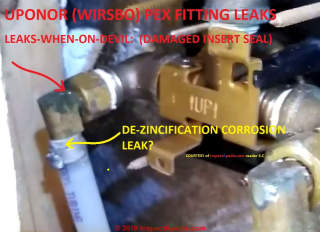 2019/11/08 InspectApedia.com reader Southward.C. reports by his ain video having found leaks at PEX connectors used to connect Uponor TuffPEX tubing to a brass shower command.
2019/11/08 InspectApedia.com reader Southward.C. reports by his ain video having found leaks at PEX connectors used to connect Uponor TuffPEX tubing to a brass shower command.
South.C. institute corrosion that may exist de-zincification discussed above, just significantly he constitute that the combination of over-tightening of the brass PEX-to-Fixture connector crushed, carve up, or otherwise damaged the Wirsbo / Uponor PEX connector seal inserts leading to leaks that could be difficult to rail downwards - the fittings leaked only when the shower was on.
The red arrow points to blackened corrosion at the fitting'southward insert into the connector to the shower control. (The shower control is new, the original one having been replaced).
This leak was due to a damaged UPONOR (Wirsbo) PEX tubing seal that inserts into the fitting end that connects to the shower control.
A second leak is developing at the aforementioned fitting, shown by the white mineral salts around the plumbing equipment nearly the clamp securing the UPONOR TuffPEX to the fitting (yellow pointer).
Below the reader holds the original UPONOR TuffPEX fitting seal - a yellow ring intended to seal the plumbing fixtures to the female threaded connection of, in this case, a shower control water inlet line.
The shredded PEX fitting yellow sealing ring is probably due to over-tightening at original installation but might also be caused by subsequent re-tightening of the connector in an effort to cease a leak that could be from the seal OR could be from mistaking a leak due to de-zincification in the brass plumbing fixtures itself for a loose plumbing fixtures.
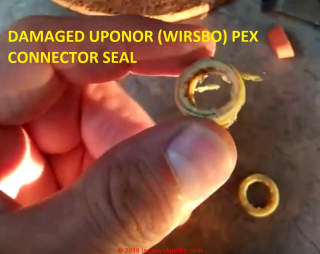
The photo below illustrates a tapered blood-red PEX fitting sealing ring sold as a replacement to repair leaky PEX fitting seals. This tapered cherry PEX fitting seal ring is provided past PlumbMaster.
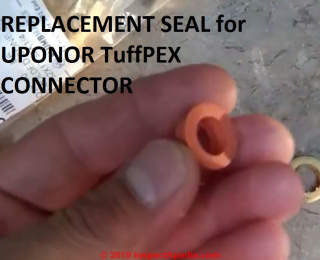
Watch out: OPINION: if your PEX fittings are corroded and if you're not sure that the leak is due to the seal rather than to pinhole leaks in the contumely fitting, it may bes to just replace the fittings rather than risk ongoing leak harm and the cost of doing the same repair job twice.
- PlumbMaster, 2951 Highway 501 Eastward, Conway S.C. 29526 USA. Website: https://world wide web.plumbmaster.com/wolverinebrass/ Tel: ane-800-523-5130
As well encounter "Leaks-When-On Devils" discussed
at LEAK TYPES, H2o SUPPLY or DRAIN PIPES.
- SharkBite Plumbing Solutions, SharkBite United states of america 2300 Defoor Hills Rd. NW Atlanta, GA 30318 United states of america Tel: i-877-700-4242
SharkBite Canada 74 Alex Avenue Vaughan, Ontario, L4L 5X1 Canada, tel: 1-888-820-0120 retrieved 2020/01/19 original source: https://www.sharkbite.com/
SHARKBITE INSTALLATION GUIDE [PDF] (2018) Reliance Worldwide Corporation 2300 Defoor Hills Rd NW, Atlanta, GA 30318 Phone: 1-877-700-4242 Fax: i-877-700-4280 rwc.com Reliance Worldwide Corporation (Canada) Inc. 74 Alex Avenue Vaughan, Ontario, L4L 5X1 Telephone: i-888-820-0120 Sales Inquiries: canadasales@rwc.com Orders: canadaorders@rwc.com retrieved 2019/08/xiii original source: https://www.sharkbite.com/sites/one thousand/files/rgohfh321/files/2018-05/SharkBite_Installation_Instructions_2018_WEB.
Reader Comments & Q&A
Question: installing PEX in concrete
(July 17, 2014) Anonymous said:
When putting pex in physical practise you lot demand to pressurize the system before you pour the concrete?
Reply:
While I tin can't cite an administrative reference, certainly I've never seen a organization pressurized before installation. I do see that the pex tubing is capped and supported above the slab to keep it accessible and clean at its connexion points.
Question:
(Nov 8, 2014) Anonymous said:
Afterwards the Zurn, Uponor and other class action lawsuits related to dezincification problems with contumely fittings, did they take measures to correct the problem and if so how can I exist certain I am not purchasing a defective brass plumbing fixtures?
Respond:
You may take missed it, but the article to a higher place reports ongoing leak concerns, most likely where water chemistry is an important factor.
...
Continue reading at PEX Piping INFORMATION - topic home, or select a topic from the closely-related articles below, or meet the complete Commodity INDEX.
Or run across these
Recommended Articles
- LEAK TYPES, WATER SUPPLY or Drain PIPES
- PEX Piping INFORMATION
- PLASTIC Pipage ABS CPVC PB PEX PVC - domicile folio
- PLASTIC vs. COPPER PIPES in BUILDINGS - separate article
- PLASTIC Piping LEAK CAUSES
- PlumbPex® PEX LEAKS & LAWSUIT - separate commodity
- Kitek® PLASTIC PIPELEAKS & LAWSUIT - split article
Suggested commendation for this web folio
PEX BRASS CONNECTOR LEAKS at InspectApedia.com - online encyclopedia of building & environmental inspection, testing, diagnosis, repair, & problem prevention advice.
Or run across this
INDEX to RELATED ARTICLES: Article INDEX to PLUMBING SYSTEMS
Or use the SEARCH BOX establish below to Ask a Question or Search InspectApedia
...
Inquire a Question or Search InspectApedia
Endeavour the search box just below, or if you adopt, mail a question or comment in the Comments box beneath and we will respond promptly.
Search the InspectApedia website
Note: appearance of your Comment beneath may exist delayed: if your annotate contains an image, web link, or text that looks to the software every bit if it might exist a spider web link, your posting will appear subsequently it has been approved by a moderator. Apologies for the delay.
Technical Reviewers & References
Click to Show or Hide Citations & References
Publisher InspectApedia.com - Daniel Friedman
Source: https://inspectapedia.com/plumbing/PEX_Brass_Fitting_Leaks_De_Zincification.php
Posted by: dalemeleat.blogspot.com


0 Response to "How To Repair Pex Piping"
Post a Comment